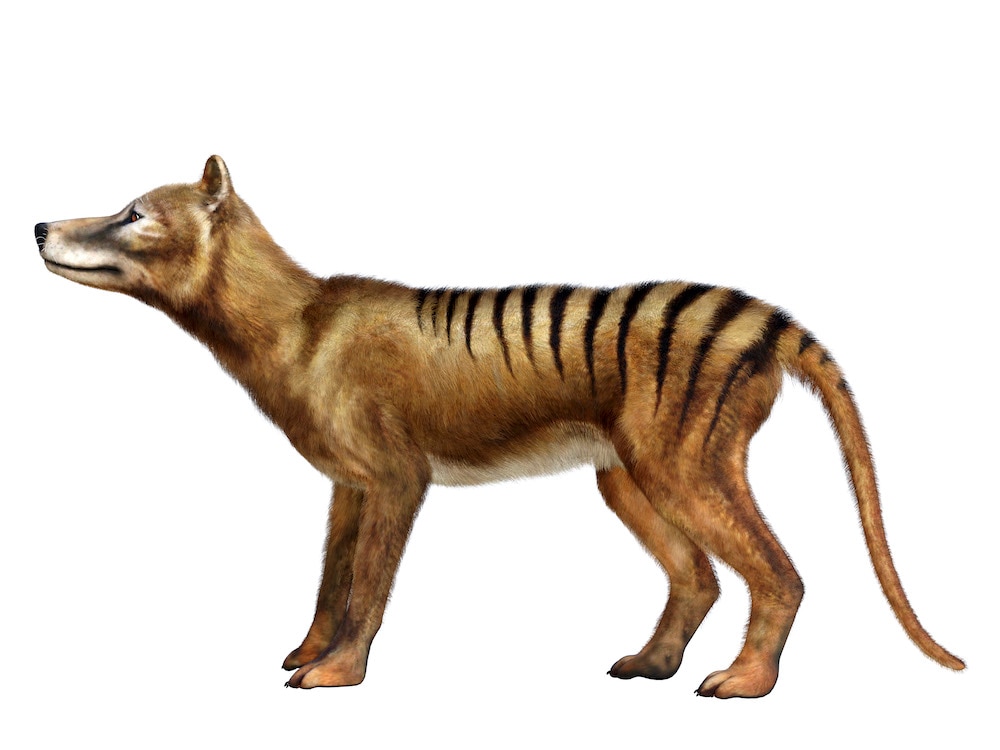Create a free profile to get unlimited access to exclusive videos, sweepstakes, and more!
Now we have an instruction manual for resurrecting the extinct Tasmanian Tiger
We're about to play the ultimate genetic Uno reverse card.

Tasmanian tigers, also known as Tasmanian wolves or thylacines, hold a special place in the history of conservation. They were the only member of their family, thylacinidae, which made it to modern times. They were strange looking animals, an amalgamation of features from animals we’re more familiar with today. They shared some features with wild dogs, though their bodies were comparatively squat, and they had a series of 15 to 20 stripes along their back half. They were also one of the only marsupial species in which both the males and females had pouches.
Evidence suggests the species appeared about 4 million years ago and the last confirmed thylacine died in a zoo on Sept. 7, 1936. That date has been observed as National Threatened Species Day in Australia since 1996. The species wasn’t officially recognized as extinct until 1982 and there are unconfirmed sightings of the species, even today. Though, most scientists don’t give those reports any credit.
The fate of the Tasmanian tiger can be traced directly back to human interference. A combination of habitat loss and a directed hunting and bounty program resulted in the decline and disappearance of the species. All these years after the last Tasmanian tiger died, we have an opportunity to reverse course and bring them back.
A team of scientists at the University of Melbourne, lead by Professor Andrew Pask, recently received a philanthropic gift of $5 million AUD to be used for the Thylacine Integrated Genetic Restoration Research Lab, TIGRR for short. The goal of the project is to develop a program for the resurrection of the species.
Conversations around the resurrection of extinct species often center on whether or not a population could exist in a world which may no longer resemble the one they used to inhabit. The historical habitat of the Tasmanian tiger has remained largely unchanged, making them a good candidate for de-extinction. To that end, Pask and colleagues have outlined a nine-step process for returning the Tasmanian tiger to its previous niche.
The monetary gift the lab received should fund 10 years of research, which is roughly how long Pask believes it should take, and the program is already off to a good start. The first two steps involve sequencing the thylacine genome and the genomes of its closest living relatives. Those two steps have already been completed. A high-quality thylacine genome was sequenced in 2018, and we’ve also sequenced the genomes of the fat-tailed dunnart and the marsupial mouse, two of the thylacines closes living relatives.
The genomes of the dunnart and the marsupial mouse will provide a foundation upon which a Tasmanian tiger embryo could be constructed. The next step in the process is comparing the thylacine genome to its living relatives to identify the genes which would need to be edited to make an embryo. From there, scientists will need to get stem cells from model species, at present they are targeting the fat-tailed dunnart for this step.
The next steps involve developing assistive reproductive technologies, essentially nailing down the process of embryo creation and transfer to a living surrogate. The team believes that marsupials have a particular advantage for resurrection, owing to their comparatively short gestation periods.
Anyone familiar with kangaroos knows that joeys are born very early in the development process and spend the remainder of their development in the pouch. Tasmanian tigers had a similar reproductive process, meaning the amount of time the embryo would need to develop inside a surrogate is brief.
The final steps involve developing a process for taking newborns from the surrogate and raising them to independence, probably via bottle feeding away from the surrogate. We may even be able to grow newborns without using a surrogate at all.
The road ahead is long and complex, but advances in de-extinction technologies have become more common in recent years, as evidenced by efforts around the black-footed ferret and the northern white rhino. In the meantime, Pask and colleagues believe these technologies will have benefits for living and threatened species.
We should make every effort to minimize our negative impact on the species which share our planet, but it’s nice to know that if all else fails, we might be able to undo our mistakes.


























